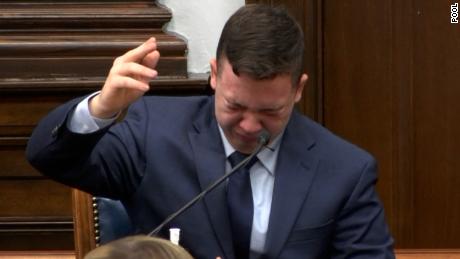A jury of 12 people will begin a second day of deliberations Wednesday morning in Kyle Rittenhouse's homicide trial for the fatal shooting of two people and wounding of another during last year's unrest in Kenosha, Wisconsin.
The jury, made up of five men and seven women, began deliberating on five felony charges Tuesday morning. They have asked two questions of the court, both to get extra copies of the case's 36-page jury instructions.
The deliberations come after a two-week trial highlighted by emotional and compelling testimony from Rittenhouse, the 18-year-old at the center of debates around self-defense, gun ownership and Black Lives Matter demonstrations. On the stand, he told jurors -- and the viewing public -- that he acted in self-defense.
"I didn't do anything wrong. I defended myself," he testified.
Rittenhouse is charged with five felonies: first-degree intentional homicide, first-degree reckless homicide, attempted first-degree intentional homicide and two counts of first-degree recklessly endangering safety. Jurors are also able to consider lesser offenses for two of the five counts. If convicted on the most serious charge, Rittenhouse could face a mandatory sentence of life in prison.
Judge Bruce Schroeder dismissed a misdemeanor weapons possession charge and a non-criminal curfew violation prior to deliberations.
The charges stem from the chaotic unrest last year in the wake of the Kenosha police shooting of Jacob Blake, a 29-year-old Black man. After instances of rioting and fiery destruction, Rittenhouse, 17 at the time, took a medical kit and an AR-15-style rifle and joined up with a group of other armed people in Kenosha on August 25, 2020.
There, Rittenhouse fatally shot Joseph Rosenbaum -- who was chasing the teenager and threw a bag at him -- and then tried to flee. A crowd of people pursued the teenager, and Rittenhouse shot at an unidentified man who tried to kick him; fatally shot Anthony Huber, who had hit him with a skateboard; and wounded Gaige Grosskreutz, who was armed with a pistol.
What happened in the trial
Prosecutors called 22 witnesses over the course of six days as they sought to show Rittenhouse acted recklessly that night and provoked Rosenbaum by pointing the rifle at him, setting off the ensuing series of events.
"That is what provokes this entire incident," prosecutor Thomas Binger said in closing arguments. "When the defendant provokes this incident, he loses the right to self-defense. You cannot claim self-defense against a danger you create."
The prosecution portrayed the three other people who confronted the teen as "heroes" trying to stop what they believed to be an active shooting. Binger also questioned the teenager's decision to take a gun into the city in the first place, calling him a "chaos tourist."
However, on the stand, Rittenhouse testified he acted in self-defense when he shot four times at Rosenbaum, who he said had threatened him earlier, chased him, thrown a bag at him and lunged for his gun. Rittenhouse also referred to the three other people he shot at as part of a "mob" chasing him.
He became emotional and broke down into tears during his testimony as he began to recount the initial shooting, leading to a break in the case.
In closing arguments, defense attorney Mark Richards said Rittenhouse feared for his life when he opened fire.
"Every person who was shot was attacking Kyle. One with a skateboard, one with his hands, and one with his feet, one with a gun," Richards said. "Hands and feet can cause great bodily harm."
The trial featured more than a dozen videos from the night that showed what happened before, during and after the shootings. Most of the facts of what happened that night were not up for debate -- rather, at the heart of the trial was the analysis of Rittenhouse's actions and whether they can be considered "reasonable."
The prosecution faced an uphill challenge in the case because Wisconsin law requires the state to prove beyond a reasonable doubt that Rittenhouse did not act in self-defense. But there are limits to a self-defense claim.
"The defendant may intentionally use force which is intended or likely to cause death or great bodily harm only if the defendant reasonably believed that the force used was necessary to prevent imminent death or great bodily harm to himself," the jury instructions explain.


